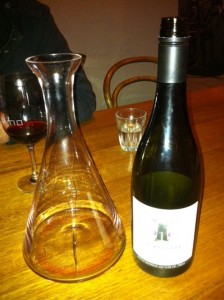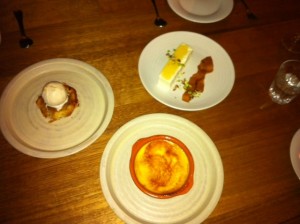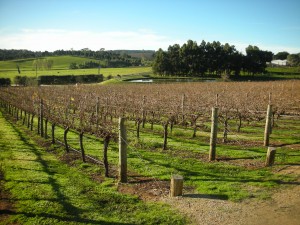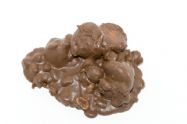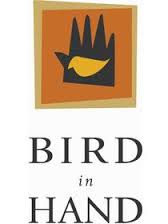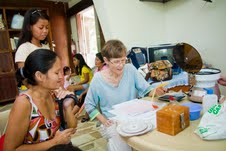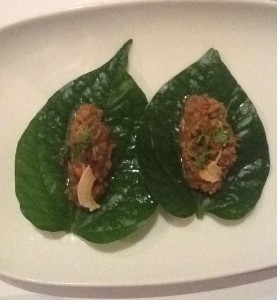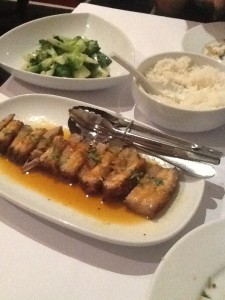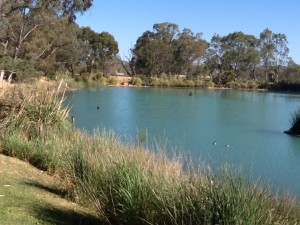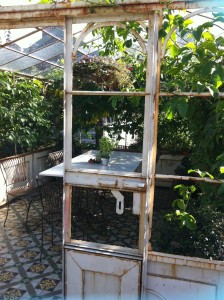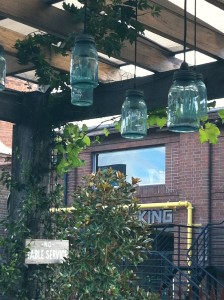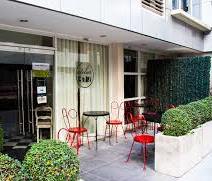 I first introduced Atelier 317 back in March. Since then, this quirky little restuarant in the back streets of Barangay Poblacion has gone from strength to strength.
I first introduced Atelier 317 back in March. Since then, this quirky little restuarant in the back streets of Barangay Poblacion has gone from strength to strength.
Owner, Stephanie Zubiri-Crespi, designed the restaurant herself, and it feels like a small French café, with its black and white tiled floor and French provincial chairs. The décor is an eclectic collection of furniture and furnishings she found in a local flea market, including an old sewing machine table and a small, wrought iron garden setting. A series of her mother’s paintings of fruit and vegetables adorn the walls, while the upstairs gallery houses an exhibition of abstract photographs by local artist Risa Recio. Stephanie has collected crockery and coffee cups from all over the city. “I find stuff” she says.
The name ‘Atelier’ is French for an artist’s studio or creative space. The number 317 belongs to the house where she first set up her catering business in Palm Village. When the priest blessed the new venture in Brgy Poblacion, he apparently drew other references from the numbers: three in one equals the Holy Trinity; Atelier is Stephanie’s first restaurant; it is open seven days a week, and God created the world in seven days, and so on…
Stephanie talks with ease about her life and her work and is happy to share her 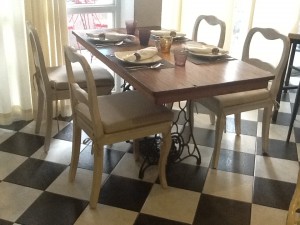 inspiration. She enjoys collaborating with fellow chefs and her theory of food is one word: simplicity. “I believe in the simplicity of things. Overly complicated is not my style.” She loves slow cooking and makes her own stocks and sauces from scratch. “It’s important not to take short cuts” she tells me, “and the ingredients must be fresh.”
inspiration. She enjoys collaborating with fellow chefs and her theory of food is one word: simplicity. “I believe in the simplicity of things. Overly complicated is not my style.” She loves slow cooking and makes her own stocks and sauces from scratch. “It’s important not to take short cuts” she tells me, “and the ingredients must be fresh.”
She tells me she has always been interested in food. “While some parents have to force their kids to eat, Mum had to drag me away from the table!” she laughs. So when she finished school (she is an ISM alumnus), she flew to Paris to do a Cordon Bleu cooking course. She tells me that while the training was excellent, she couldn’t appreciate the inflexibility of French cooking. “It was really tough and rigid… the opposite of who I am.” She also took wine courses, and travelled and tasted her way around Europe. She would backpack with a group of friends, who saved their pennies for gourmet dinners by staying in the cheapest accommodation they could find. Stephanie went on to study history and geography at the Sorbonne, aiming for a career in the diplomatic corps or journalism, and continued to travel and eat whenever she could.
After six years in Paris, Stephanie came home to the Philippines, still undecided about her future. Her mother suggested she continue to cook while she was figuring it out. Stephanie started by teaching cooking classes and moved into catering. She was so successful, a hobby became a business. Three years passed in a blur of hard work, stress and constant activity. When she stopped to draw breath, she decided to move out of catering to create her own restaurant.
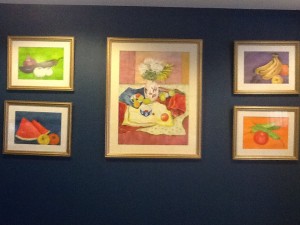 Now, polished and stylishly dressed, with never a hair out of place, she sits in her eerie above the restaurant, gloating at having the time to do so, after three years on the run. Yet she won’t sit still for long. Stephanie is a diminutive power house who is forever rushing onwards and investing in her experiences. And she continues to enjoy experimenting with food. Lately her Mediterranean/Filipino fusion menu has seen a change, as she gradually adds in some Asian flavours. “I cook food that I like to eat,” she states, “if it sells, it stays, if it doesn’t, it goes.”
Now, polished and stylishly dressed, with never a hair out of place, she sits in her eerie above the restaurant, gloating at having the time to do so, after three years on the run. Yet she won’t sit still for long. Stephanie is a diminutive power house who is forever rushing onwards and investing in her experiences. And she continues to enjoy experimenting with food. Lately her Mediterranean/Filipino fusion menu has seen a change, as she gradually adds in some Asian flavours. “I cook food that I like to eat,” she states, “if it sells, it stays, if it doesn’t, it goes.”
Two of her own favourites on the current menu are Vietnamese Cha Ca La Vong (dory fillet sautéed in turmeric and lemongrass) and a Sri Lankan Black Chicken Curry. I have been back several times for the Limoncetta: a derivation of Spaghetti Carbonara optionally served with smoked salmon. Stephanie also shares the creations of other local chefs, such as Alexandra Rocha’s White Chocolate Black Truffle ice cream.
Not content with just opening a restaurant, she added to the challenge by staying out of the mainstream locations. I have no argument with this, gratefully escaping from Manila’s ubiquitous shopping malls, but it is a brave choice that doesn’t allow for passing trade. The customers come anyway, and Stephanie is buzzing with new ideas and plans. In February, she opened Le Galerie, a new space above the restaurant, with a fully operational kitchen and a cozy dining area for up to sixteen people. This versatile space has already been used for private dinners, photo shoots, art exhibitions and cooking demos. The restaurant serves brunch, lunch and dinner, and Stephanie has recently added a set menu for business lunches from Monday to Friday, and a happy hour with tapas from 4pm – 8pm daily. The latest idea is to have afternoon teas based on her favourite tea selection from Harney & Son.
for passing trade. The customers come anyway, and Stephanie is buzzing with new ideas and plans. In February, she opened Le Galerie, a new space above the restaurant, with a fully operational kitchen and a cozy dining area for up to sixteen people. This versatile space has already been used for private dinners, photo shoots, art exhibitions and cooking demos. The restaurant serves brunch, lunch and dinner, and Stephanie has recently added a set menu for business lunches from Monday to Friday, and a happy hour with tapas from 4pm – 8pm daily. The latest idea is to have afternoon teas based on her favourite tea selection from Harney & Son.
In her spare time, Stephanie writes a foodie column for the Philippine Star and contributes to the magazine Travel & Leisure SE Asia… and she is still trying to decide what she will do when she grows up!
Atelier 317 is located on the ground floor of the Palm Rock Building, 6060 Palma cor Osias Street, Poblacion, Makati
For further information or reservations call 02-358-0987 or text 0917-830-8393 or look on the website: www.epicurusinc.ph/atelier-317.aspx
*First published in ANZA News, July/August 2013 issue.


